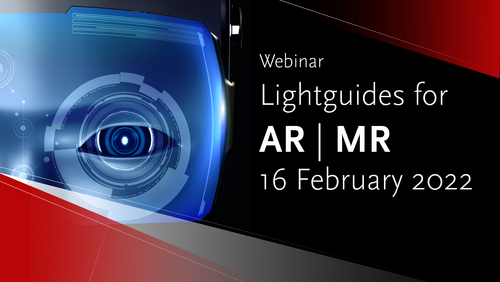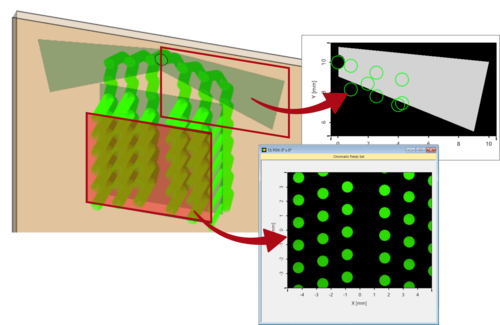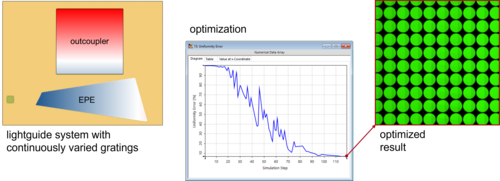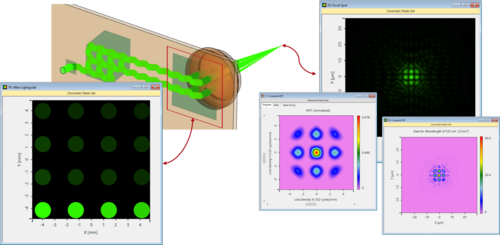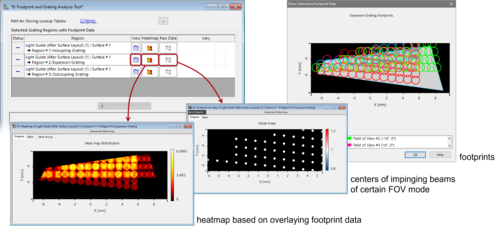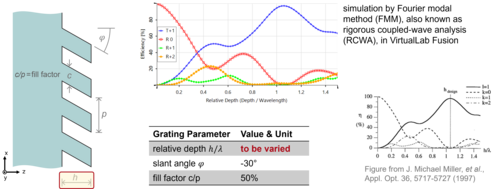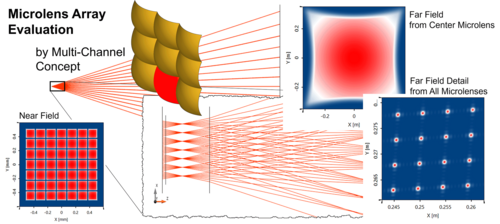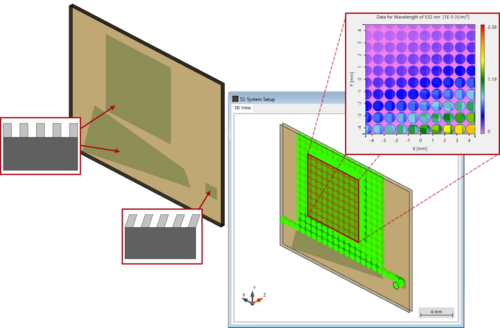What’s new in our Optical Modeling and Design Software?
Save Your Seat for Our First Webinar and Meetup in 2022 on Lightguides for AR & MR
Webinar
Analysis and Optimization of Lightguides for Augmented & Mixed Reality
16 February 2022 | 10:00 and 18:00 (CET)
User Meetup
Lightguides for AR & MR with Holographic and Surface-Relief Grating Couplers
23 February 2022 | 10:00 – 17:45 (CET)
Modeling of Lightguide Devices with Complex Expansion Regions in VirtualLab Fusion
In the past weeks we have shown the powerful capabilities of the fast physical optics modeling and design software VirtualLab Fusion for the design and simulation of lightguide systems. We now culminate this campaign with a demonstration of the application of these technologies to simulate examples from literature with complex eye-pupil-expander (EPE) regions.
See below two examples, one containing a setup with a “butterfly" EPE, that splits the field of view (FOV), and another one illustrating a 2D-periodic diamond-shaped grating structures in the combined expander/outcoupler region.
Read moreOptimization of Grating Geometries in Lightguide Systems
In our last newsletter we highlighted the capabilities of the fast physical optics software VirtualLab Fusion to analyze the performance of lightguide systems. This time we address a closely related step in the design workflow: the optimization of the grating geometries used in the coupling and expansion regions of the system.
VirtualLab Fusion offers a series of powerful tools for this task: for instance, detectors that calculate fundamental merit functions like uniformity and efficiency, and moreover the possibility to implement a (custom) smooth variation of the grating parameters along a specific region of the layout. The latter approach can drastically decrease the number of free parameters in the optimization while at the same time retaining crucial flexibility. For more information, check out the examples below!
Read morePerformance Investigation of Lightguide Systems
The design process of any optical system must include an investigation of the performance of the system as a crucial step. Of course, this includes lightguide devices for applications in the field of augmented and mixed reality (AR/MR), as relatively complex representatives of optical systems. Depending on the application, “performance” can be defined by different merit functions. VirtualLab Fusion provides the optical engineer with a set of helpful tools and detectors to investigate the properties of the system.
Below we demonstrate two examples centered around the performance evaluation of lightguides: an NED (“near to exe”) device with 2D pupil expansion and a human eye model in order to calculate the MTF & PSF, and another one on characterization of the lateral uniformity.
Read moreFootprint and Grating Analysis
The Light Guide Toolbox of the fast physical optics software VirtualLab Fusion provides a series of tools to help the optical engineer with many of the different stages involved in the design of lightguide devices for augmented and mixed reality applications. In our recent newsletters we already covered some of the features that assist, for instance, in the determination of a sufficient layout for the lightguide and its grating regions.
Today we turn to one of the most powerful systematic design tools for gratings in lightguides: the Footprint and Grating Analysis tool. Among its many functions, which are not limited to any particular layout, it can help, for example, to visualize the interactions of the beam footprints with the grating regions for the different field-of-view modes – an important study, considering the complex propagation of light inside the lightguide. But the jewel in its crown is its capacity to perform an analysis of the grating behavior that can then be used to configure a smooth variation of the grating parameters inside a single grating region, with the aim of improving the performance of the device in terms of its uniformity and efficiency.
Learn more about it with the use cases below!
Read moreGrating Analysis for Lightguide Applications
As we saw in last week’s newsletter, grating structures with various shapes are often an essential part of lightguide-based display systems for augmented and mixed reality applications. The complexity of the gratings and the manifold roles they usually play in these setups require a thorough analysis of their behavior, while the small feature size means a rigorous method is necessary to perform said analysis accurately. The fast physical optics modeling and design software VirtualLab Fusion puts several tools at your disposal to make this task easier and more user-friendly.
This time, we want to highlight the Grating Order Analyzer, which uses the rigorous Fourier Modal Method/Rigorous Coupled Wave Analysis (FMM/RCWA) for grating characterization and illustrate its application in the case of a slanted grating for lightguide incoupling.
Read moreRegister for Our Upcoming Webinar & Meet Us at Photonics West!
Webinar
Advanced Modeling of Microlens Arrays with VirtualLab Fusion
23 November 2021 | 10:00 and 18:00 (CET)
Exhibition
SPIE Photonics West
25 – 27 January 2022 | San Francisco, USA
Moscone Centre | German Pavilion A #4429-15
Real Grating Effects in Lightguide Applications
For the purposes of in- and outcoupling light, as well as for guiding the light from a source to the intended eyebox, different kinds of surface relief or even holographic gratings are commonly used. The design of these gratings in regard to efficiency and uniformity is therefore one of the major challenges in the design process of AR/MR devices. VirtualLab Fusion provides the optical designer with a variety of different tools to investigate grating properties and an easy way to apply the designed grating structures onto the lightguide surface. This enables the detailed simulation of the whole device including all relevant effects, like polarization and coherence.
Read more



